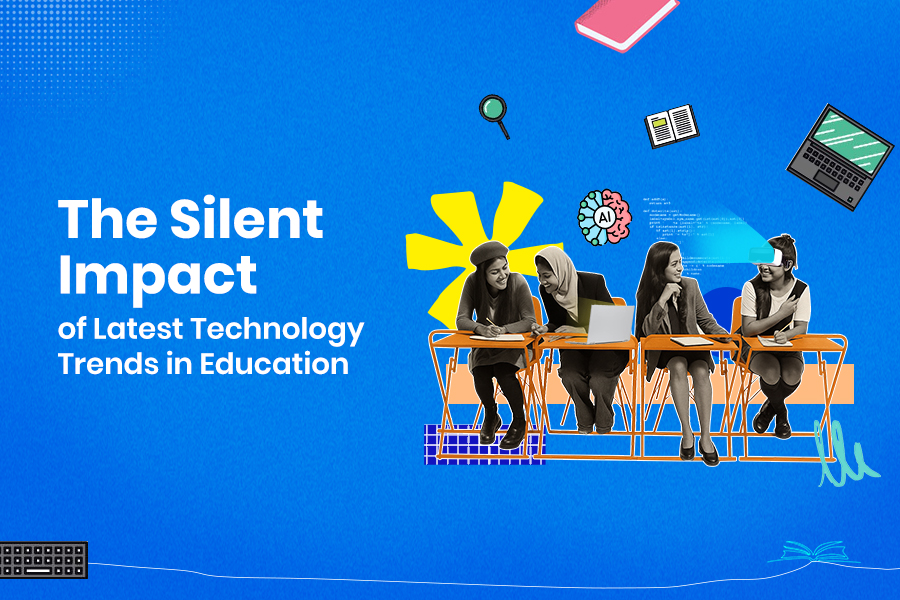
The Indian education system is one of the strongest in the world. Despite being a country with one of the largest populations, India provides exceptional educational facilities for its students. The government is effectively incorporating the latest technology trends in education.
However, India also faces some major challenges when it comes to its education system. They include lack of infrastructure, funding issues, inadequate qualified teachers, outdated curricula, and so on. These challenges are dragging India down.
The NEP 2020 and UGC’s move to allow foreign universities aim to enhance accessibility, quality, and skill-based learning. Technology trends such as AI in education, AR/VR, IoT, and personalised learning are reshaping education, making it more engaging, practical, and future-ready.
Do you want to find out more about these? Let’s go!
The Current State of Higher Education in India
Before understanding the latest technology trends in education, we have to learn about the current state of higher education in India.
The current state of Indian higher education is marked by both challenges and opportunities.
The government of India provides substantial funding to public universities to make higher education accessible to everyone.
India has been home to numerous educational institutions that provide knowledge and skills to a wide range of students. This makes them future-ready for the global economy.
What are the challenges in Indian higher education?
Despite having numerous educational institutions, there is a shortage of funding and quality faculty. Many of these institutions also lack resources and infrastructure that can make students future-ready for emerging technologies.
One of the best tips for students to overcome this is leveraging online platforms, internships, and skill-based programs to fill gaps where traditional institutions fall short.
What are the Steps taken by UGC Regarding Foreign Universities?
What is UGC?
The UGC (University Grants Commission) is the apex regulatory body for Indian higher education. It coordinates, determines, and maintains standards for higher education in the country. UGC also provides financial assistance to colleges and universities and monitors their administrative and academic performance.
When talking about the current state of Indian education, the UGC framework regarding universities from abroad under the NEP (New Education Policy) 2020 is important.
As per this framework, foreign universities can set up their campuses in India (provided they meet certain criteria). This policy promotes partnerships between foreign and Indian universities.
How can this Step Transform Higher Education in India?

This policy has the potential to bring many benefits to Indian higher education:
- Access to Top-Notch Education: As the regulation aims to set up foreign university campuses in India, students will have access to world-class facilities and education.
- Enhanced Quality: The competition between foreign and Indian universities will drive up the quality of education. This will lead to better learning outcomes.
- Increased Opportunities for Research: Through partnerships between Indian and foreign universities, there will be an expansion of research facilities and opportunities. This will drive growth and innovation.
- Skill Development: With the introduction of new campuses, the availability of specialized courses is expected to increase. This will help students skill up for the future by developing in-demand skills that will enable them to succeed in a globalised world.
What is the NEP (New Education Policy) 2020, and how does it affect Indian Education?
In recent times, the Indian education system has seen a massive shift. All thanks to the NEP (New Education Policy) 2020.
What is the NEP 2020?
The NEP was launched in 2020 with an aim to change the outdated educational structure and make it relevant to modern needs. It aims to provide high-quality learning to all the students by focusing on holistic learning and improving the quality of assessments, learning, and teaching practices.
The NEP 2020 focuses on areas like:

- Accessibility: It makes sure that all learners, irrespective of their backgrounds, have access to education.
- Reforms in Curriculum: NEP provides a shift from theoretical learning to experiential learning. It focuses on problem-solving, creativity, and critical thinking.
- Education in Different Languages: It promotes the use of multilingualism (particularly local languages) in education.
- Digitised Learning: NEP 2020 further focuses on the use of technology, supporting digitised learning in schools, colleges, and universities.
How does the NEP 2020 Impact Students?
The New Education Policy’s goal is to address the issues of modern learners and prepare them for a technology-first world. By focusing more on a practical approach, the policy helps students to develop a wide range of skills.
The NEP brings the following changes that affect students:
- Students will be more independent in choosing subjects of their choice and interest. This will reduce the pressure of compulsory learning and encourage them to learn things they are passionate about.
- The NEP 2020 recognises the importance of vocational learning along with conventional learning. So, they will get the exposure to different skills and career choices from an early stage.
- This policy promotes a personalised approach to learning. This will help the students in learning at their own pace. So, the education system will benefit both gifted and slow learners.
The Top 10 Technological Trends in Education in 2025
The last few years have seen a drastic change in the learning approach. The way students are taught nowadays is very different from what it used to be in the last 10 years.
Much of the credit goes to technology. It has brought changes in the way students learn and the way teachers teach.
So, we will discuss the 10 latest technology trends in education in India. So, without further ado, let’s explore all that and more.

1. Collaborative Learning Approach
This is one of the most innovative and latest technology trends in education. This made everyone stay connected during learning.
In this approach, the students connect, discuss, and take action collaboratively. More often than not, teachers promote collaboration in classrooms by carrying out group tasks.
When students collaborate with each other, they acquire collaborative skills. Working together can help them understand each other and increase engagement. So, this allows students to have excellent communication and collaborative skills that are required in professional spaces.
2. Remote Learning Technology
eLearning and mLearning have been the new norm in education. With the rise of mobile devices, the learning approach has been taken outside the classroom.
With the help of these learning approaches, students can learn at their own pace. This is one of those technology trends in education that delivers as a convenient approach to receiving and delivering education. So, the impact of digital tools on education is massive.
With offline reading features, an internet connection is no longer a problem. EBooks can be used with other features to improve the learning experience. Most of the training institutes and other educational institutions have adopted this kind of learning approach.
3. Social Media Learning
Who would have thought that social media would be used as a learning tool? Social media learning has been one of the latest technology trends in education.
Children as young as 11 years old use social media. So, instead of restricting them to use social media, educators are using it to turn it into a learning tool. This is one of the most powerful tools that enhances learning significantly.
In addition, educators have started using social media as a communication tool too. They help students to interact with their teachers and peers.
Teachers leverage social media to make sure the students stay interested in the subject through constant engagement.
4. Immersive Learning
The rise of AR (Augmented Reality), VR (Virtual Reality), and other interactive learning platforms has had a huge impact on learning approaches. Through these technologies, education has become more immersive and interactive.
Instead of practical experiments and static images, students can now view interactive images and objects on electronic devices. This makes the learning approach massively engaging. So, this is one of those technology trends in education that has revolutionised the learning outcome.
5. Gamification
This trend has been gaining popularity for a simple reason. Gamification in education increases engagement. We have now seen gamification being used in classes such as reward points, leader boards, stickers, badges, and so on.
Of all the latest technological trends in education, it is that one trend that promotes participation, competition, and engagement. With this, the students get involved in activities to enhance their leader board rankings. This needs to lead the leaderboard results in better retention and continuous improvements.
6. Personalised Learning
Simply put, personalised learning is an approach that tailors learning and teaching according to students’ preferences and needs. This is a part of a data-driven education approach.
In 2025, personalised learning will become more relevant because of AI and data analytics. Educational institutions can use AI to assess learner data and provide recommendations on learning, content, and pacing strategies.
7. Adaptive Learning Systems
Adaptive learning approaches offer personalised educational journeys. This is done by adjusting difficulty and content based on student responses. This technology identifies students’ weaknesses and strengths to provide a personalised approach and recommendations.
The learning outcome is efficient as it caters to the needs of each student.
8. IoT in Smart Classroom Environments
The Internet of Things, or IoT, integrates objects with the internet. This can be done in classrooms, creating smart environments.
IoT devices such as smart lab equipment and smartboards can enhance the learning experience by making the classroom more interactive. These IoT-driven devices offer live feedback and practical opportunities. All these prepare students for a technology-oriented world.
9. 5G-Enabled Online Learning
The rise of 5G offers uninterrupted speed and internet connectivity. This enhances online learning experiences significantly.
5G connections’ high bandwidth and low latency allow smooth video streaming, AR experiences, and virtual classrooms. This, in turn, ensures an interactive and seamless online learning environment.
10. Microlearning
Microlearning is the approach that breaks down big educational content into small, manageable units. This makes it easier for students to digest and retain information. This is an excellent approach in higher education and corporate training.
Microlearning approaches often integrate multimedia elements, which enhance student engagement and learning outcomes.
Webskitters Academy: An Institute where Technology Trends are a Reality!
It was just a matter of time before the education sector was transformed by technology. Although the adoption rate was quite low in the beginning, the incorporation of technology gained momentum slowly. The learning and teaching approaches have undergone a shift through the latest technological trends in education.
Just as changes are constant, innovation in the educational field is also constant. Each year, trends emerge to help students learn more and more effectively.
Webskitters Academy is one such institution that strives to provide the best possible experience for its students. We keep a track of the major technological trends and incorporate them in our course structure to make our students future-ready.
Do you want to level up your skills with a learning approach that makes you ready for the emerging technologies? Contact us now and boost your career!
FAQs
1. What are the major challenges in Indian higher education?
Lack of infrastructure, funding, and qualified faculty remains a key challenge.
2. How is UGC improving Indian higher education?
UGC allows foreign universities to set up campuses in India, ensuring quality education and global exposure.
3. What is the NEP 2020, and why is it important?
NEP 2020 reforms the education system by focusing on accessibility, practical learning, and skill development.
4. How are technology trends reshaping education in India?
AI, AR/VR, IoT, and personalised learning are making education more engaging and future-ready.
5. What role does Webskitters Academy play in modern education?
Webskitters Academy integrates the latest technology trends into its courses to prepare students for emerging careers.
Search
I Want to Learn...
Category
Explore OurAll CoursesTransform Your Dreams
into Reality
Subscribe to Our Newsletter
"*" indicates required fields
 New Year Special Discount Offer - Upto 20% Off on all Course Fees - 50 Seats Available
New Year Special Discount Offer - Upto 20% Off on all Course Fees - 50 Seats Available 







